
La Sagrada Família Basilica is the symbol of the city, the final masterwork of the modernist architect, Gaudí, as well as his final resting place (he is buried in the crypt). Redesigned by Gaudí in 1883 and built under his direction until his death in 1926, the still unfinished cathedral is slated for completion in 2026 and will include the addition of 10 more spires.
Barcelona is the capital of Catalonia and the second-largest city in Spain. The city is best known for its striking architecture (a mix of modernist and Catalan Gothic styles), its wealth of art from Romanesque to surrealism, its all-star football team, outstanding food culture, and gorgeous seaside and mountain landscapes. With balmy weather almost year-round, Barcelona makes a wonderful year-round destination, though it especially shines in the late spring and early fall months.
The Barcelona Travel Guide
- Skip to our Barcelona FAQ
Barcelona Basics
Barcelona Hotels
- Best Hotels in Barcelona
- Best Hotels in Barcelona for Families
- Best Budget Hotels in Barcelona
- Best Boutique Hotels in Barcelona
- Barcelona Airport Hotels
- Barcelona Hotel Map
Barcelona Activities
- Best Tours & Things to Do in Barcelona
- Best Restaurants in Barcelona
- Best Bars in Barcelona
- Best Tapas Bars in Barcelona
- Best Barcelona Shops & Markets
- Barcelona with Kids
Barcelona Trip Planning
Frequently Asked Questions about Barcelona
Where is Barcelona?
Barcelona, often shortened to Barça, is the capital of the Catalan autonomous community in northeastern Spain. This coastal city sits on the Mediterranean Sea; its 2000-year-old port is among the ten largest and busiest in Europe. 1.6 million people live inside the city limits, and an additional 3.2 million live in the surrounding metropolitan area. Barcelona sits 140 km south of Andorra, 200 miles north of Mallorca, 280 km northeast of Ibiza, 300 km northeast of Valencia, 330 km southwest of Marseilles, 460 km southwest of Monaco, and 500 km east of Madrid. Barça has direct, high-speed trains connecting it to dozens of cities within Spain and 12 cities in France. Barcelona’s ferries connect the city with Mallorca, Ibiza, Italy, Morocco, and more.
Barcelona’s 2000-year-old port and the Barceloneta neighborhood, as seen from Jardins del Mirador on Montjuïc Hill.
When is the best time to visit Barcelona?
Overall, the best months to visit Barcelona are during the first two weeks of March, anytime in May, and from mid-September through the end of October. These times offer the best combination of less crowded attractions and good weather, though October can see some rain. Avoid visiting in the height of summer when the weather can be scorching, crowds tend to be thick, and lines at attractions run long. The winter months (November through early March) are best for cheaper room rates, deals on flights, and thinner crowds. In general, January is the coldest month; August is the hottest. October is the wettest month; June is the driest.
The famous FC Barcelona football team competes from late August through late May (with a break a the end of December); games tend to fall on weekends.
What is Barcelona known for?
According to myth, Barcelona was founded by Hercules, who was struck by the area’s natural beauty after his Fourth Labor, helping Jason and the Argonauts find a lost ship. Barça still boasts an enchanting landscape, now filled with whimsical modernist and Catalan Gothic architecture. The coastal city is well-loved for its beaches, with white sand stretching out for three miles. The city is famously a modern art hub, with world-class museums featuring early works by Picasso and the surrealist masters Dalí and Miró. The city’s rich culinary tradition is based around seafood, pork, Mediterranean vegetables, and sweet-savory sauces; don’t miss a chance to try fideuà (a local paella-like dish made with short noodles instead of rice). In local sports, football (soccer) is king. The city’s Camp Nou Stadium is the largest football stadium in Europe and home to the legendary FC Barcelona, consistently ranked one of the world’s best teams.
What are the best areas to stay in Barcelona?
The 14th-century Barcelona Cathedral is the quintessential model of Catalan Gothic architecture, the dominant building style of the 13th through 15th centuries. The Barri Gòtic (Gothic Quarter) is the oldest part of the city and is filled with medieval buildings and charming lanes.
Though the city is divided into several districts, most travelers will want to stay in one of Barcelona’s central neighborhoods for easy walking or public transportation to the city’s best hotels, dining, attractions, and shopping. The most central and best all-around for first-timers, families, and romantic occasions is Barri Gòtic, the oldest part of the city, a warren of medieval lanes and Catalan Gothic architecture that’s been inhabited since Roman times. El Born sits east of Barri Gòtic and offers similar ease of access to excellent dining and sights, plus it’s closer to the city’s beaches and adjacent to Parc de la Ciutadella and the Barcelona Zoo. For shorter trips, upscale Eixample is a smart choice with top luxury hotels convenient to the city’s main attractions, including Gaudi’s masterful Sagrada Familia, Casa Batlló, and La Pedrera; the neighborhood Sant Antoni is part of Eixample, packed with many of the city’s best restaurants, lively tapas bars, and upscale cocktail bars. El Raval is the best spot for living like a local. This former red-light district offers an artsy vibe with museums, independent galleries, vintage boutiques, trendy restaurants, and lively tapas bars. To the east is coastal Barceloneta, popular for its long, white-sand beaches, low-key and excellent-quality seafood restaurants, a top-tier aquarium, and the scenic cable car up the hill to Montjuïc Park with its rambling gardens, castle, museums, and panoramic viewpoints. At the northern base of Montjuïc lies Poble Sec known for its trendy vibe, tapas bars, and live music venues fringing the foodie street Carrer de Blai. On the south end of Poble Sec, there is a cable car up to Montjuïc Castle. For a slower pace and artsy atmosphere away from the noise of the city center (yet with easy bus access), Gràcia is an excellent area. Home to Park Güell, Gaudi’s largest work – a 17-hectare public park, beautifully landscaped and filled with outlandish architecture, tile mosaics, and sculptures inspired by nature.
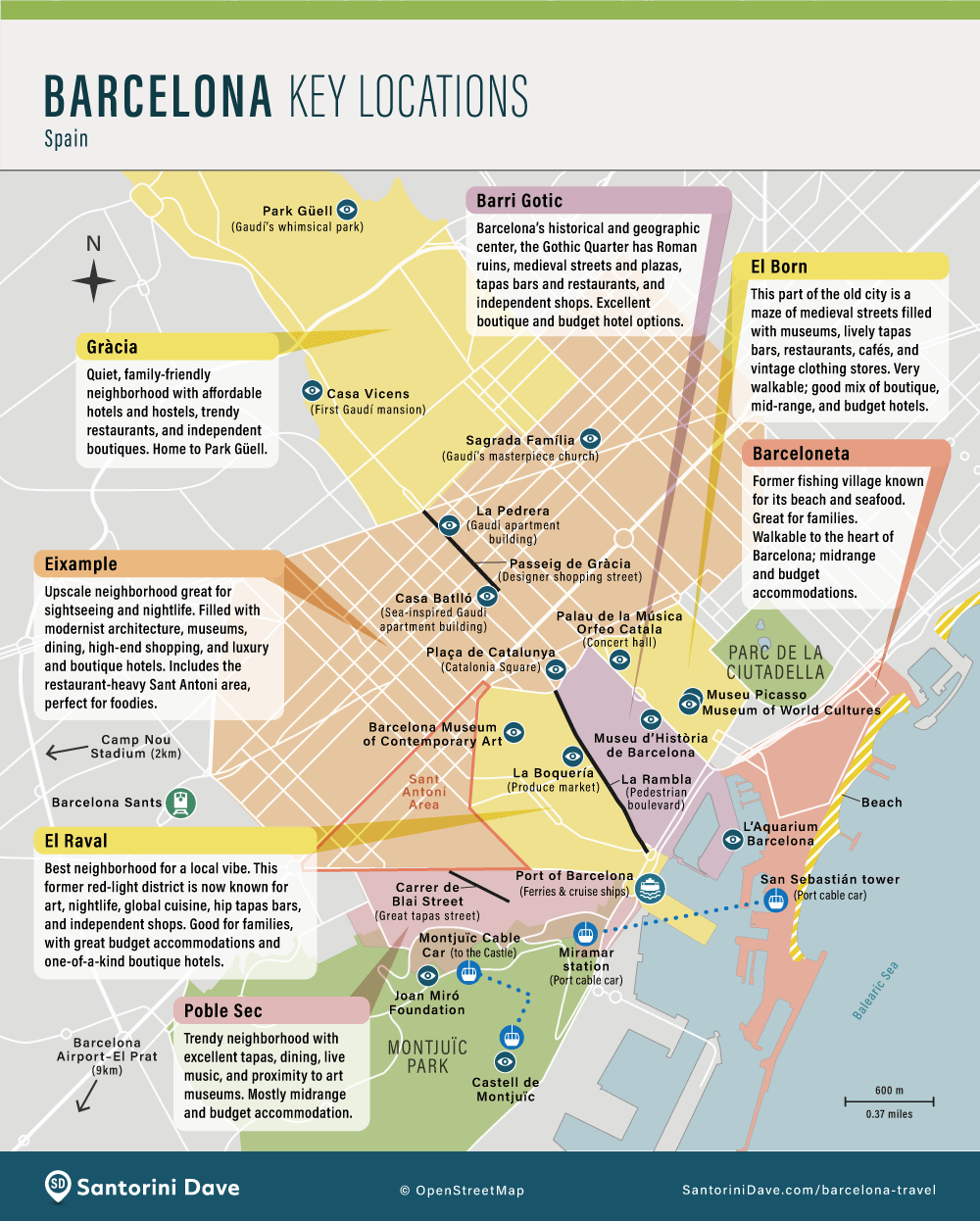
What cities have direct flights to Barcelona?
Many cities in Europe, North America, and worldwide offer direct flights to Barcelona. From Europe, direct flights are available from most major cities and travel hotspots, including Amsterdam, Athens, Dublin, Frankfurt, Ibiza, London, Lisbon, Madrid, Milan, Munich, Mykonos, Naples, Paris, Prague, Rome, Vienna, Zurich, and many more. European flights to Barça take 1 to 3 hours.
From North America, direct flights are available to Barcelona from Atlanta, Mexico City, Miami, Montreal, New York City, Newark, and Toronto and take 7.5 to 11 hours. A handful of cities in South America offer direct flights to Barcelona, including Bogotá, Buenos Aires, Santiago, and São Paulo, and take 10.5 to 13.5 hours.
Direct flights from Africa are on offer from Algiers, Cairo, Casablanca, Dakar, Marrakesh, and Tunis and take from 1.5 to 4.5 hours. From the Middle East, Barça direct flights leave from Amman, Abu Dhabi, Beirut, Doha, Dubai, Istanbul, Tel Aviv, and take anywhere from 3.5 hours up to 7.5 hours.
Few Asian cities offer direct flights to Barcelona, among them Hong Kong, Seoul, and Singapore. Flights take about 13.5 hours from any of these cities.
How long should I plan to spend in Barcelona?
Most of Barcelona’s iconic sights and top museums (Sagrada Familia, can be seen in 3 full days, but allow 5 days to get a more in-depth feel for the city’s local neighborhoods or if you plan to visit Barças sprawling parks (Montjuïc, Park Güell, Ciutadella, or Tibidabo, which can easily take a half-day each), to add in a beach day at Barceloneta, or to take in a football game. Plan extra time, too, for a day trip to Montserrat Monastery, Sitges, Girona, Figueres (Dalí’s hometown), or Cadaqués. No matter how long you stay in Barcelona, taking a guided tour is an excellent way to make the most of your time while gleaning insight into the city’s vibrant culture and vital history.
Sant Sebastià beach in Barceloneta at sunset. If visiting in summer, plan a beach day. Barcelona is fronted by 3 miles of white sand beach with wonderful swimming, seafood restaurants, L’Aquarium, and a cable car to Montjuïc.
How do I get around in Barcelona?
Barcelona is a highly walkable and bikeable city with most of its best-loved sights, restaurants, and markets within 3.5 km of the city center and plenty of sidewalks and bike lanes traversing the city. Barça also boasts one of the best public transportation systems in Europe, with a network of trains, trams, buses, funiculars, and cable cars connecting each neighborhood to one another and to the farther flung parks, suburbs, and nearby towns. The metro (local trains) is usually the fastest way to get around the city, but it only runs until midnight most evenings. Buses are faster to the beach than the train and run 24-hours a day, but they are a little slower getting around town due to traffic. A single ticket for the bus, tram, metro, or local train (staying inside the city, not the suburban trains) costs €2.40. Tickets are good for 1 hour and 15 minutes from the start of the ride and include one transfer. A T-casual ticket is good for 10 rides at a discounted rate, or pick up an Hola Barcelona pass for 2, 3, 4, or 5 days of unlimited rides and transfers. Funiculars and cable cars are the most fun modes of travel, connecting the beach and Poble Sec to Montjuïc Park and Montjuïc Castle, and with routes to the top of Tibidabo and to Montserrat Monastery. Taxis are a great option for night travel or for traveling with children and luggage. Taxis tend to be more affordable in Barcelona than in other European cities. There is no Uber in Barcelona. A car is a hassle for getting around town, but a scooter is easier to park and zip through the narrow streets.
Most of Barça’s landmarks are within a short walk of the city center. A few, like Park Güell here, are easier to reach by metro or bus for those staying in the heart of the city.
Is Barcelona safe?
Barça is not only a gorgeous city but a safe place to visit, as well. Like any major European travel hub, most crimes here center around pickpocketing, while violent crime is uncommon. Look out for pickpockets near train stations, popular tourist attractions, and nightlife hotspots. Be aware of your surroundings, keep your wallet and phone safely stashed, and hang any purses or bags diagonally over your chest (not straight over your shoulder or slung on your back). At night, be on the lookout in particular on the south end of La Rambla, near the Sants train station, on the north side of Montjuïc, near La Boqueria food market, and around the popular bars of El Raval, El Born, and Barri Gòtic, where drunk partiers can get out of control.
Another element to consider in Barcelona is the Catalan independence movement, which has sparked some heated protests in recent years, though most protesting is done peacefully. Follow the news ahead of your trip to see if any areas of the city are affected.
Barcelona is among the world’s safest major cities, though travelers should keep an eye out for pickpockets, especially at night and in popular tourist areas like La Rambla, seen here. The streets of Barcelona are fairly well-lit.
What language do they speak in Barcelona?
Unlike the rest of Spain, most people in Barcelona speak Catalan in addition to Spanish. Catalan is a romance language derived from Latin, as is Spanish, but it is more closely related to French and Occitan (a French/North Italian language). Use of the Catalan language was banned during the Francoist dictatorship from 1939 to 1975, so many older Barcelonans speak Spanish as their first language. Catalan became the official language of Catalonia, Barcelona’s region, in 1979. Younger Barcelonans tend to grow up in Spanish-speaking households, attend Catalan-speaking schools, and use Catalan in most official settings. Younger Barcelonans and those working in the travel industry often speak some English.
To hear the Catalan language in song, visit the Palau de la Música Catalana and take in a performance by the Orfeó Català, the Catalan choral society. This Catalan Art Nouveau palace was built especially for the choir in 1905.
What currency is used in Barcelona?
Spain is part of the European Union, and the currency used in Barcelona is the euro (€). Most attractions, restaurants, bars, and shops accept credit cards, but it’s a good idea to carry a little cash for food and souvenirs at the open-air markets, taxi fare, and bottled water. ATMs are easy to find throughout Barcelona.
Tipping is not mandatory in Barcelona, but it is a fairly common practice and is always appreciated. Tipping is reserved for good service only, and is generally a few euros or rounding up the change. In general, at a restaurant tip from 5% up to 10% of the bill but not over €10 (no matter how fancy or expensive the restaurant is). For bars, tapas, or cafes, round up the change to the nearest euro. Taxi drivers don’t expect tips, unless they help with luggage; rounding up the change or tipping a euro or two is plenty. In hotels, €1 a day is typical for maid service,€1 per bag is typical for a porter, and €1 for room service delivery. Tipping tour guides is standard, though what amount is considered normal varies. Tips of €2 per person or 15% of the bill are equally common.
It’s best to carry a little cash when hitting the outdoor flea and food markets, like Mercat Gòtic here, open every Thursday for 40 years in front of the Barcelona Cathedral.

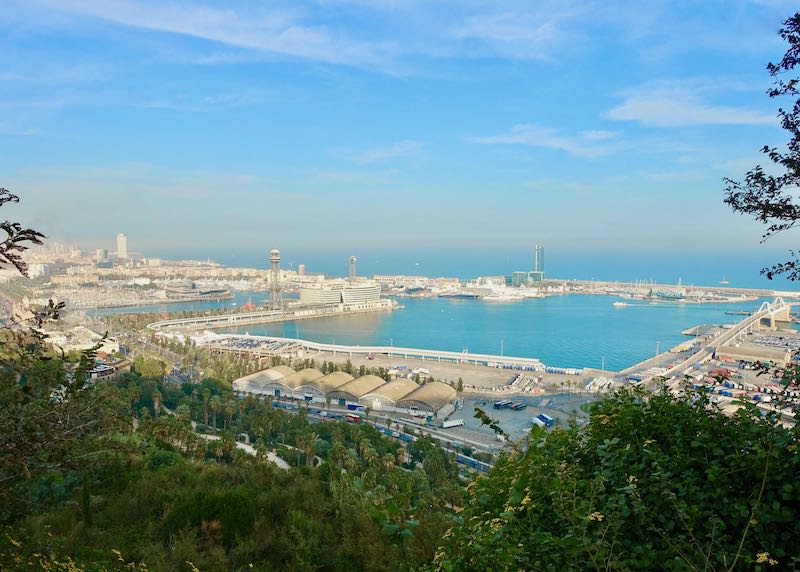
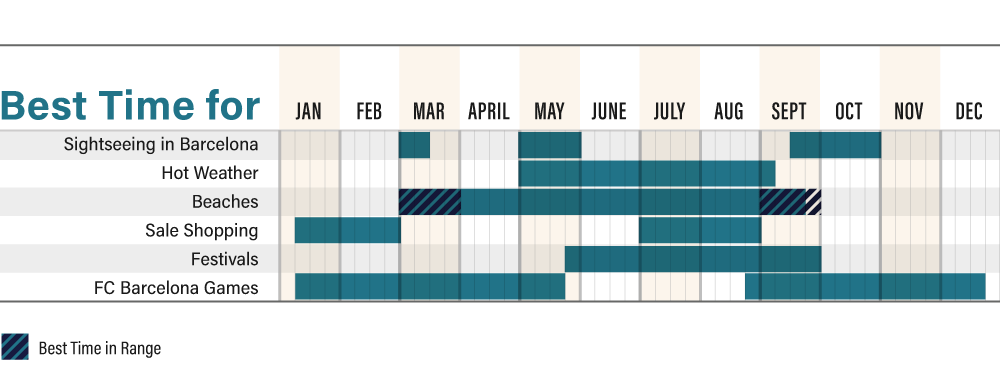

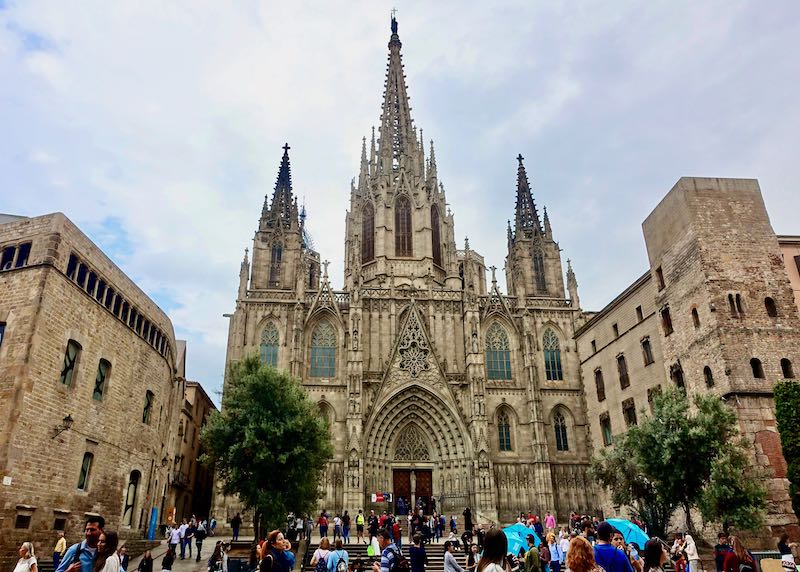
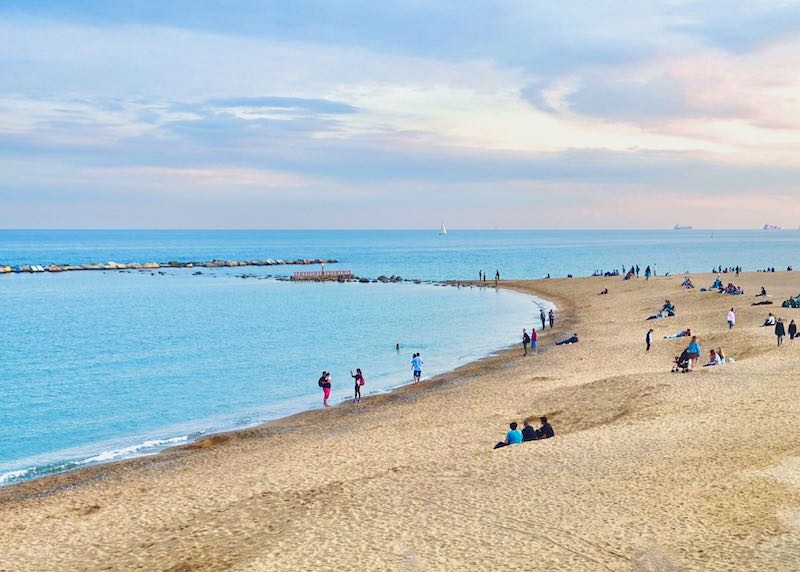
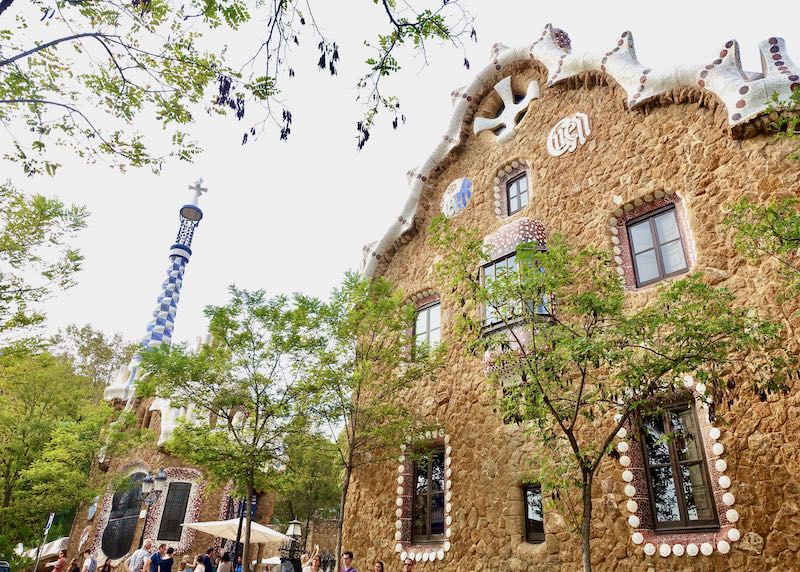
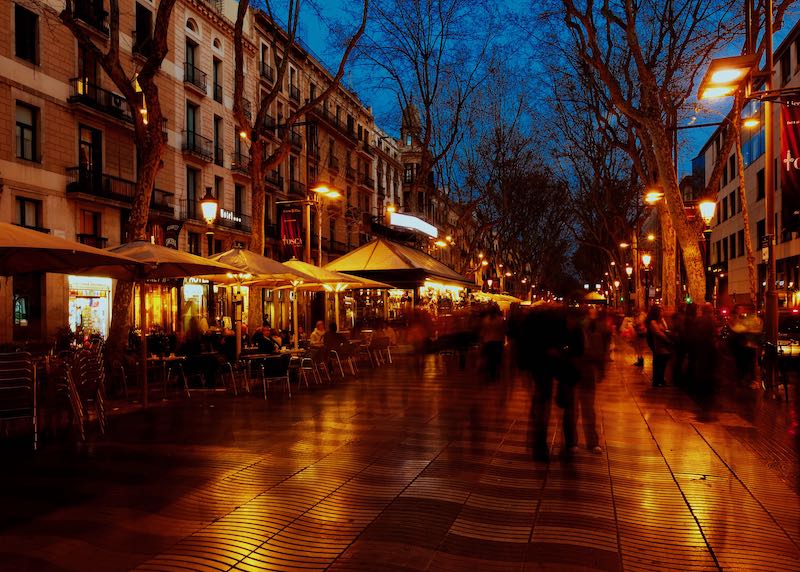
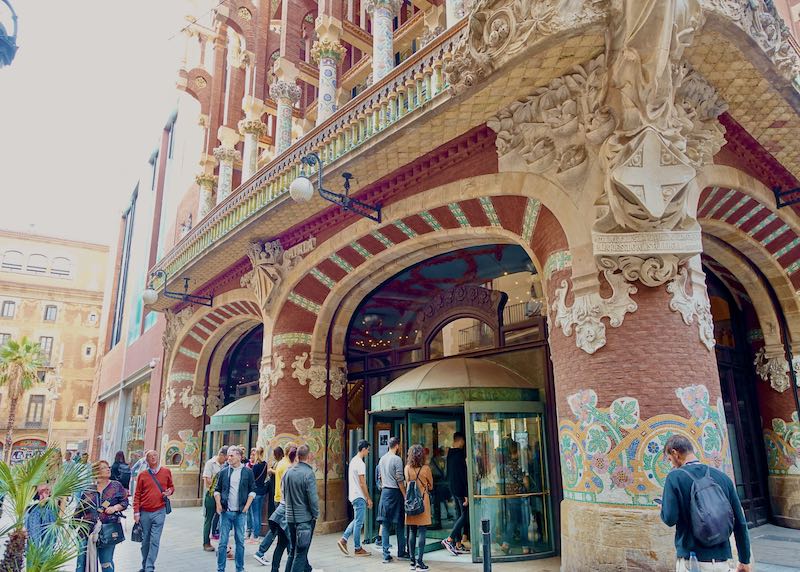
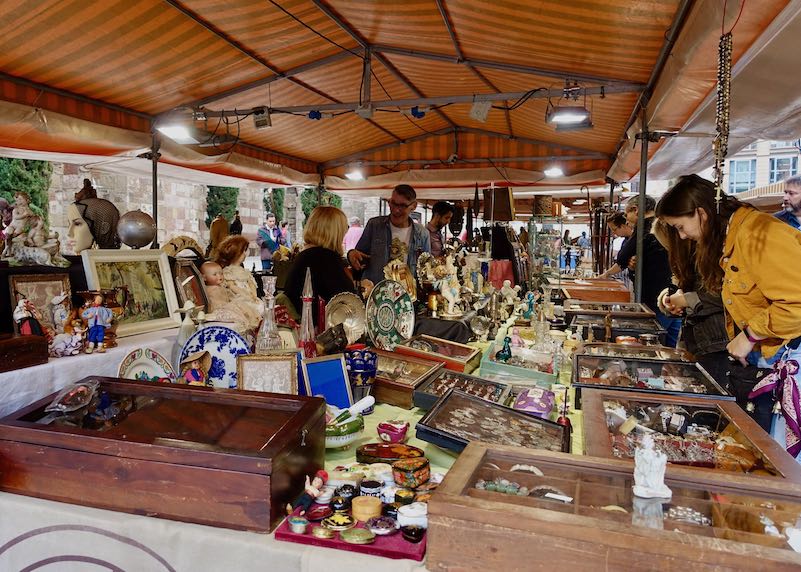
About Santorini Dave